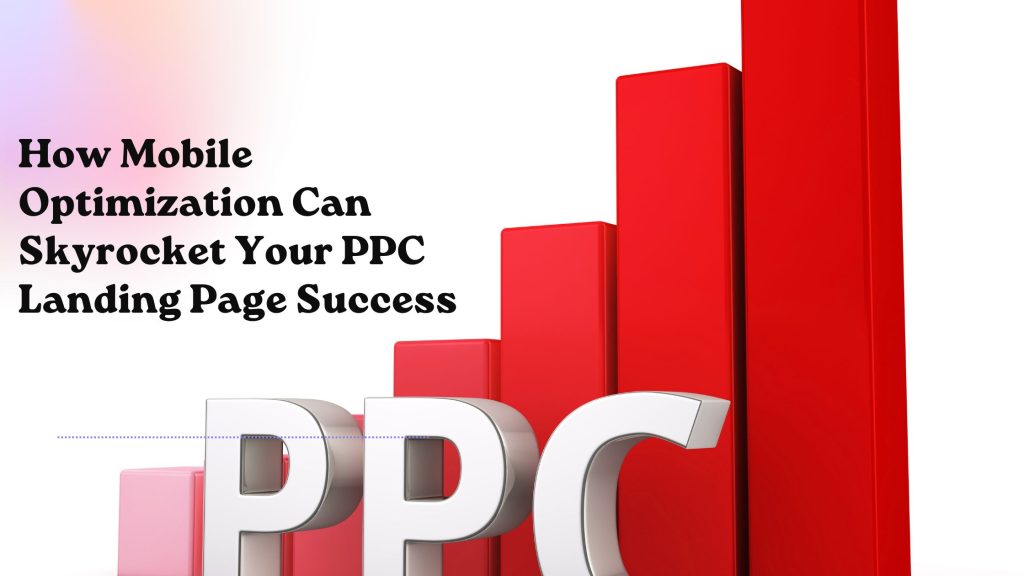Smartphones have become essential to our daily lives, offering a tremendous opportunity for marketers and advertisers. Mobile pay-per-click (PPC) advertising is a powerful way for brands to boost awareness and drive results. With PPC campaigns generating 50% more conversions than organic efforts, optimizing mobile PPC campaigns is a smart move for any brand. Beyond these clear advantages, PPC ads also deliver higher click-through rates (CTR) and a stronger return on investment compared to other advertising formats. Mobile optimization for PPC not only enhances user satisfaction but also drives higher click-through rates, better conversions, and a stronger return on investment.
Mobile optimization can truly skyrocket your PPC landing page success by ensuring visitors have a seamless experience regardless of their screen size. Whether you’re running ads on social media platforms or search engines, understanding how to tailor your content for mobile users is essential in maximizing conversions and boosting ROI.
In this article, we’ll delve into the importance of mobile PPC optimization and provide actionable strategies to engage mobile users effectively. Whether you’re just starting with mobile advertising or seeking to fine-tune your campaigns, these insights can help enhance your results.
Mobile Optimization and PPC Landing Pages
Mobile optimization refers to the process of making websites and landing pages user-friendly on mobile devices. With consumers increasingly browsing and shopping on their smartphones, ensuring a smooth experience is vital for PPC campaigns.
PPC landing pages serve as the bridge between your ads and conversions. If these pages aren’t optimized for mobile, you risk losing valuable leads. Slow loading times or poor navigation can frustrate potential customers before they even interact with your content.
Moreover, Google considers mobile-friendliness when ranking sites in search results. A well-optimized page not only enhances user experience but also improves visibility in searches. This dual benefit makes it essential to prioritize mobile optimization across all PPC initiatives.
The landscape continues to evolve, meaning businesses must stay ahead by embracing responsive design principles that cater specifically to mobile users’ needs.
The Importance of Mobile Optimization for PPC Landing Pages
Mobile optimization is no longer optional; it’s a necessity. As smartphone usage surges, more users are searching and shopping via their devices than ever before. This trend means your PPC landing pages must cater to the mobile experience.
A well-optimized mobile landing page enhances user engagement. It reduces bounce rates by ensuring visitors find what they need quickly and effortlessly. Fast loading speeds capture attention instantly, keeping potential customers interested in your offerings.
Moreover, Google prioritizes mobile-friendly sites in its rankings. If your landing page isn’t optimized for mobile, you risk losing visibility in search results—impacting both organic traffic and paid campaigns.
With seamless navigation and appealing design tailored for smaller screens, you create a positive impression of your brand. This trust can lead to higher conversion rates as visitors feel comfortable taking action right away.
Tips for Optimizing Your PPC Landing Page for Mobile Devices
Start with a responsive design. Ensure your landing page adapts to various screen sizes seamlessly. A mobile-friendly layout enhances user experience significantly.
Focus on speed. Mobile users often have limited patience. Compress images and minimize scripts to boost loading times. Every second counts in retaining potential customers.
Use clear, concise calls-to-action (CTAs). Make buttons large enough for easy tapping, and position them prominently on the page. Effective CTAs guide users toward conversion without friction.
Limit text input fields too. The less typing required, the better the user experience will be on mobile devices. Consider alternative methods like click-to-call or one-click form submissions.
Test rigorously across devices and browsers. Regular testing helps identify any issues that could hinder performance or usability, ensuring you always provide an optimal experience for users visiting via mobile.
Common Mistakes to Avoid When Optimizing Your PPC Landing Page for Mobile
One of the biggest pitfalls is neglecting mobile load speed. If your landing page takes too long to load, users will bounce before they even see your content.
Another common mistake is using desktop-focused designs. Complex layouts and heavy graphics can overwhelm mobile users. Stick to a clean, simple design that prioritizes key information.
Also, don’t overlook font size and readability. Text that’s too small or hard to read on a small screen drives visitors away quickly. Aim for larger fonts and clear contrasts.
Ignoring call-to-action buttons can be detrimental as well. Ensure they are easily tappable—users should never struggle to click through on their devices.
Failing to test across various devices may lead you astray. What works well on one device might not translate effectively elsewhere, so always check how your landing page appears across different screens.
The Future of Mobile Optimization and Its Impact on PPC Advertising
As technology advances, mobile optimization will evolve alongside it. With the rise of 5G networks, users expect faster load times and seamless interactions on their devices.
Artificial intelligence is also playing a pivotal role. AI-driven tools can analyze user behavior in real-time, allowing advertisers to tailor PPC campaigns more effectively for mobile audiences. This means more personalized ads that resonate with consumers’ needs.
Augmented reality (AR) and virtual reality (VR) are set to redefine user experiences on mobile platforms. Brands can create immersive landing pages that engage visitors like never before.
Voice search is another trend reshaping how we think about PPC advertising. As voice-activated devices gain popularity, optimizing content for vocal queries becomes essential in capturing this audience’s attention.
Staying ahead of these shifts will be key for marketers aiming to maximize their ROI through efficient mobile strategies.
Final Thoughts:
Investing in mobile optimization for your PPC landing pages is no longer optional. As mobile device usage continues to rise, the demand for seamless experiences has never been greater. A well-optimized mobile landing page can enhance user experience, increase conversion rates, and significantly lower your bounce rates.
When you prioritize mobile optimization, you’re not just improving aesthetics; you’re ensuring faster loading times, streamlined navigation, and easy access to key information—all critical factors that influence a user’s decision to convert. Given that many users will encounter your ads on their smartphones or tablets first, this investment pays off immensely.
Moreover, search engines reward sites that deliver optimal user experiences on all devices with better rankings. This means more organic traffic alongside the benefits from your PPC campaigns.
By focusing on creating responsive designs and eliminating common pitfalls seen in poorly optimized landing pages, you set yourself up for success in a competitive landscape where every click counts.
Embracing mobile optimization isn’t just about keeping up—it’s about leading the charge towards higher performance metrics and ultimately achieving unparalleled success with your PPC efforts. Your future results depend heavily on how well you adapt today.

